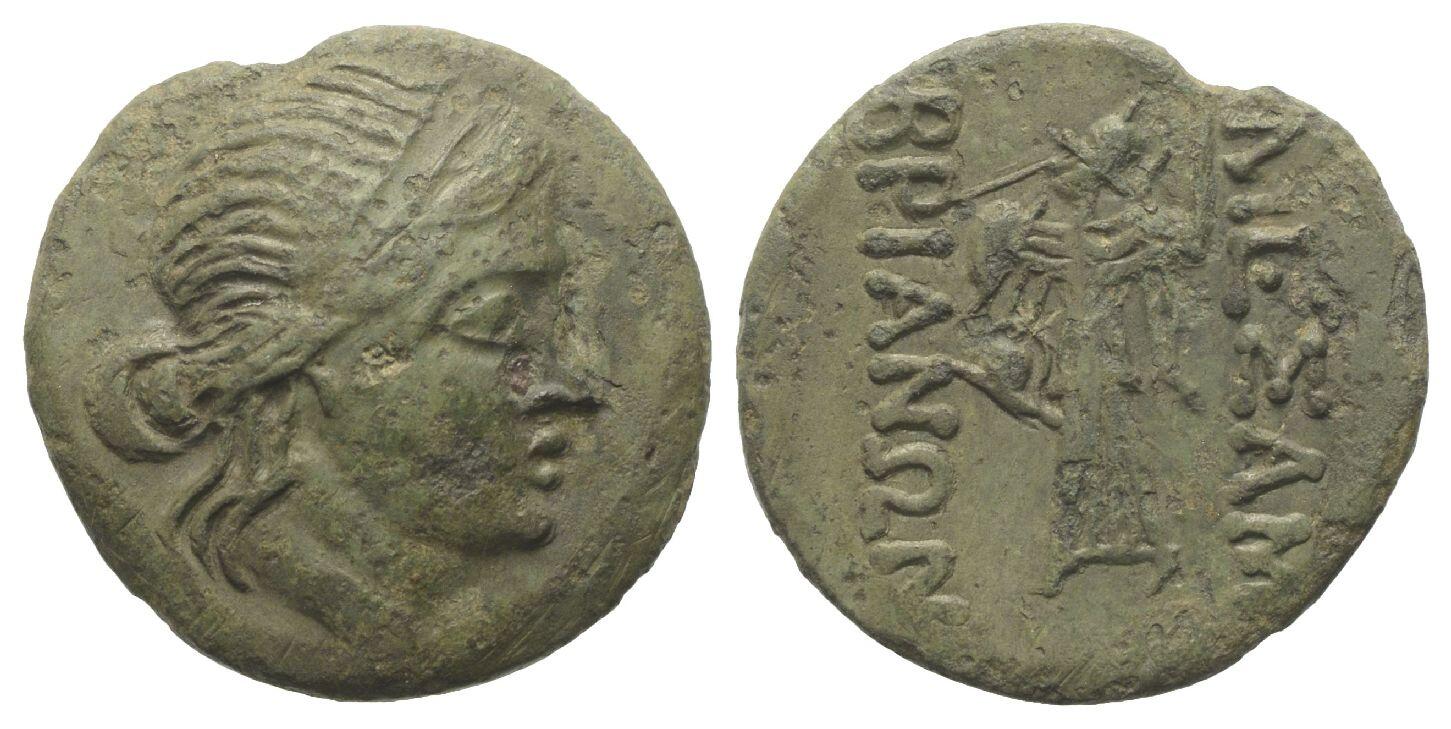Mesembria, bronze 7.40g (female head/Athena) (175-110 BCE)
From SILVER
175 BCE - 110 BCE Bronze
Description
| ObverseInscription or printing placed on the obverse.: | Female head right, wearing diadem. |
| ReverseInscription or printing placed on the reverse.: | ΜΕΣΑΜΒΡΙΑΝΩΝ (Greek).Athena Alkis standing left, holding spear in right hand, a shield attached on left arm. |
Mint and issuing power
| MintIdentifies the place of manufacture or issue of a numismatic object.: | Mesembria | Ancient regionAncient region.: | Thrace | Modern countryModern country: Bulgaria | AuthorityIdentifies the issuing power. The authority can be "pretended" when the name or the portrait of X is on the coin but he/she was not the issuing power. It can also be "uncertain" when there is no mention of X on the coin but he/she was the issuing power according to the historical sources: |
Chronology
| FromIdentifies the initial date in a range assigned in a numismatic context. | 175 BCE | toIdentifies the final date in a range assigned in a numismatic context.. | 110 BCE | PeriodTime period of the numismatic object.: Hellenistic 323-30 BC |
Physical description
| MetalThe physical material (usually metal) from which an object is made.: | Bronze |
Median weightMedian of the weights of numismatic objects (in grams). in grams | 7.40 | DenominationTerm indicating the value of a numismatic object. Examples: tetradrachm, chalkous, denarius.: | StandardStandard.: |
Image

RQEM ad. 1194 - Mesembria, bronze, 175-110 BC.jpg [1]
References
| Die study referencePublication of the study: | Karayotov 20091Karayotov 2009, p. 372-387. | ||
| Coin series referenceReference to coin series study: | Sear I2Sear I, n° 1577, HGC 3.23HGC 3.2, n° 1573 | ||
Obverse dies distribution
| FrequencyFrequency of specimen in distribution. ᵖ | Number of obversesNumber of obverse dies. ᵖ (o) | % (o) | Number of coinsNumber of coins. (n) | % (n) | Die nameName(s) of the die(s). |
| 1 | 5 | 20.83 | 5 | 2.98 | 17, 18, 19, 20, 21 |
| 2 | 7 | 29.17 | 14 | 8.33 | 3, 10, 14, 15, 16, 22, 23 |
| 3 | 2 | 8.33 | 6 | 3.57 | 11, 12 |
| 4 | 1 | 4.17 | 4 | 2.38 | 9 |
| 5 | 1 | 4.17 | 5 | 2.98 | 24 |
| 6 | 2 | 8.33 | 12 | 7.14 | 6, 13 |
| 7 | 1 | 4.17 | 7 | 4.17 | 7 |
| 10 | 1 | 4.17 | 10 | 5.95 | 8 |
| 12 | 1 | 4.17 | 12 | 7.14 | 2 |
| 18 | 1 | 4.17 | 18 | 10.71 | 4 |
| 37 | 1 | 4.17 | 37 | 22.02 | 1 |
| 38 | 1 | 4.17 | 38 | 22.62 | 5 |
| Total | 24 of 24 | 100.02 | 168 of 168 | 99.99 |
Reverse dies distribution
no distribution is available
Quantification
| Number of obversesNumber of obverse dies. ᵖ (o) | 24 | Number of singletons (o1)The number of singleton coins. ᵖ | 5 |
| Number of reverse diesNumber of reverse dies. (r) | 63 | Number of coinsNumber of coins. (n) | 168 |
| Coins per obverse dieNumber of coins per obverse die. (n/o) | 7 | Coins per reverse dieNumber of coins per reverse die. (n/r) | 2.67 |
| Reverse per obverse ratioRatio of obverse dies divided by reverse dies. (r/o) | 2.63 | Percentage of singletons (o1)number of coins (n) divided by the number of singletons (o1) ᵖ | 20.83 % |
| Original number of dies (O) (Carter 1983 formula)The estimation of the number of coins according to Carter 1983 ᵖ | 25.3 | Coins struck if 20,000 as average productivity per dieCoins made if the average productivity for obverses (according to Carter) is 20,000. ᵖ | 506,000 |
| Original number of dies (O) (Esty 2011 formula)The estimation of the number of coins according to the singleton formula in Esty 2011 ᵖ (O) | 28 | Survival rate if 20,000 as average productivity per dieSurvival rate if average productivity is 20,000. ᵖ | 0.00033 |
| Coverage (o = % of O) (Esty 1984 formula)Esty 1984 - coverage (% of O) ᵖ (o = % of O) | 97.02% | Die productivity if survival rate 1/2,000Average productivity if survival rate is 1/2,000. ᵖ | 13,280.63 |
| Weight of silver (in kg) if 20,000 coins per die (O = Carter formula)Carter 1983 * Median weight * 20000 (*10 if gold or electrum) ᵖ | n.a. | Die productivity if survival rate 1/5,000Average productivity if survival rate is 1/5,000. ᵖ | 33,201.58 |
Remarks
References
- ^ Karayotov, Ivan (2009), The coinage of Mesambria. Vol. II. Bronze coins of Mesambria, Burgas.
- ^ Sear, David R. (1978), Greek coins and their values. Vol. I, Europe, London, xl, 316 p.
- ^ Hoover, Oliver D. (2017), Handbook of Coins of Macedon and Its Neighbors. 3. Part 2: Thrace, Skythia, and Taurike, Sixth to First Centuries BC, Lancaster-London, xix, 232 p.